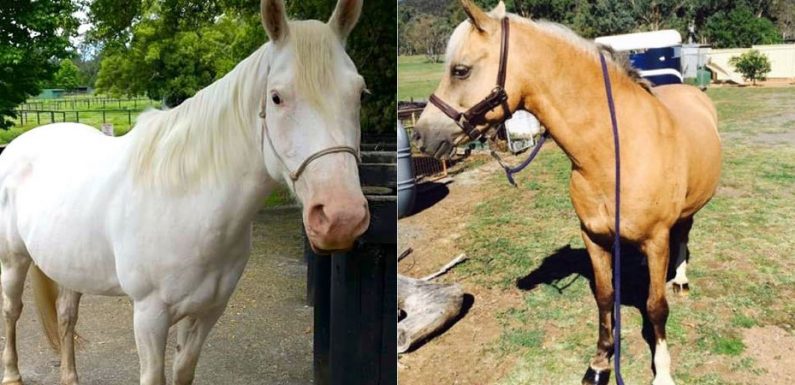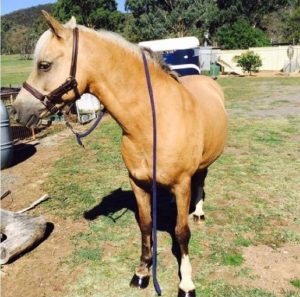
Cadbury Creme Eggs
I first wrote this article comparing the KIT gene product to a pipe clamp. But it’s heading toward Easter now, and Cadbury Creme Eggs are in the shops! I think they make an even better analogy. Cadbury Creme Eggs are made from two halves that need to go together to make a whole gooey egg.
The KIT gene
Equine coat patterns are controlled by a handful of different genes. One of these genes, called KIT, is responsible for more than half of the different coat patterns we see in horses. This overview is intended to give horse owners a conceptual understanding of why different versions of the KIT gene have the effects on white markings that they do. The different versions of KIT are known as the W genes (W is for white spotting or dominant white). Sabino 1 is also part of this group, but was named so early that it doesn’t follow the same naming tradition.
Early in the development of a foal, the blastocyst begins to develop specialised cell types that will become the different organs in the body. As the embryo develops further, cells that will become the skin start to spread out from the neural crest. The neural crest itself will later develop into parts of the head and the nerve tissue of the spine.
The skin cells we are particularly interested in are called melanoblasts. These are the progenitor cells of melanocytes, the pigment-producing cells of the skin. Their migration out to cover the developing embryo is directed by intricate feedback loops in which many genes play a role. KIT, however, seems to be very important in making sure these melanoblasts make it to their intended destination in a condition to produce working melanocytes. When melanocytes are missing there is no colour in the coat: we see this as white markings.
The KIT gene produces a protein which is part of a homodimer. This is genetics jargon for saying two individual proteins fit together to make a final working product, and those two protein units are the same as one another. Hopefully you can see the similarity to a Cadbury Creme Egg!
Unlike delicious Easter eggs, the final product that KIT makes sits in the cell membrane and plays an important role in taking signals from outside the cell to inside the cell. The signals that come via the KIT homodimer seem to be very important for keeping the melanoblasts healthy and on track to completely cover the developing embryo.
The Ws and sabino 1
So what are the W genes and sabino 1? They are versions of KIT that produce protein units that are malformed or broken. Some are only a little bit malformed (i.e. W20) and some are functionally useless (i.e. W13, W22 and many others).
When it comes to understanding how this affects your horse’s coat pattern, it’s important to remember that every horse has two copies of KIT. One is inherited from the dam, and one from the sire. Both produce protein units to be used in making the KIT homodimer. The number working functional KIT homodimers depends on pairing together units well enough that they can do their job of transmitting signals.

Let’s take W20 as an example. In our chocolate egg analogy, W20 is the crooked mold that produces halves that are a bit off. When you try to assemble eggs from mixture of good halves and crooked ones, some will leak so much delicious goo that they just need to go in the bin. For KIT, the end effect is also fewer functioning units. With fewer functioning KIT homodimer units, your horse is less likely to have melanocytes (coloured cells) at the points that are developmentally furthest from its spine: on it’s legs, belly and face.
The effect is much stronger when one of the egg half molds is completely broken. W22, for example, produces a protein unit that’s missing a large and very important section in the middle. Any gooey Easter egg made from a broken mold needs to go in the bin. (Some of you may know that W22 includes W20, so the W22 mold is both broken in the middle AND crooked.) But back from the analogy to our topic; far fewer functional KIT homodimers are being produced, far fewer signals are reaching the melanoblasts, and the spread of coloured cells out from the spine is affected even more.
W20 as a booster

Now we come to W20 as a booster of white markings. Imagine that some of your chocolate egg halves are the totally broken W22 version, and the other half are the crooked W20 ones (a W22/W20 horse). You can make a few decent eggs from the W20 versions, but not as many as you would with the proper normal ones (n). For KIT, once again, the effect is the same: the number of functional KIT homodimers is reduced to a fraction of what it should be. Those poor melanocytes don’t have much of a hope; the signal level has fallen below the threshold for being noticed at all. The end result is exactly what you’d expect: migration of the melanoblasts fails completely, and you end up with a completely white horse.
The same booster effect applies to all combinations of KIT gene variants, including sabino 1 (see illustration of Willow).
To reiterate: the difference between W20, sabino 1 and any other KIT gene variant is a matter of degree. They all produce their effects the same way, by reducing the amount of functional KIT homodimer (some more, some less). They all have some effect individually, and they all boost one another.
Variation in markings
While that covers the basic concept of what’s happening, it doesn’t explain why there is so much variation from horse to horse among those that have W20, sabino 1, or any other W gene. At the moment, our knowledge of genetics points to a few different factors which could contribute. The first is the direct effects of many other genes that also contribute to the control of melanoblast migration, which could partially compensate for the loss of the KIT homodimer (depending on how well they themselves work). The second is epigenetic control, where the use of a gene is dialed up or dialed down by long-lasting structural changes to the DNA around the gene.
To finish off, why do horses with W genes have normal brown eyes? The answer is that eyes develop from a very different type of cell to skin, one which is much less dependent on the KIT gene for normal function. The loss of the KIT homodimer simply does not have the same effect.
About the author: Dr. Kao Castle has an undergraduate degree in Advanced Chemistry, specialising in protein structure and drug design. Her doctorate was in Veterinary Science, specialising in horse genetics.